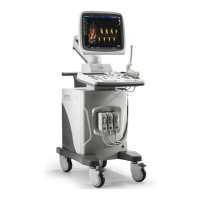SSI-6000/SSI-5800/SSI-5500/SSI-5500BW
Digital Color Doppler Ultrasound System
• Allow the transducer to air dry prior to storage or further use.
The following statement from AIUM outlines instructions for cleaning the intracavi-
tary transducer:
Guidelines for Cleaning and Preparing Endocavitary Ultrasound
Transducers between Patients from AIUM
Approved June 4, 2003
The purpose of this document is to provide guidance regarding the clean-
ing and disinfection of transvaginal and transrectal ultrasound probes.
All sterilization/disinfection represents a statistical reduction in the num-
ber of microbes present on a surface. Meticulous cleaning of the instrument
is the essential key to an initial reduction of the microbial/organic load by at
least 99%. This cleaning is followed by a disinfecting procedure to ensure
a high degree of protection from infectious disease transmission, even if a
disposable barrier covers the instrument during use.
Medical instruments fall into different categories with respect to poten-
tial for infection transmission. The most critical level of instruments are
those that are intended to penetrate skin or mucous membranes. These
require sterilization. Less critical instruments (often called “semi-critical” in-
struments) that simply come into contact with mucous membranes such as
fiber optic endoscopes require high-level disinfection rather than sterilization.
Although endocavitary ultrasound probes might be considered even less
critical instruments because they are routinely protected by single use dis-
posable probe covers, leakage rates of 0.9% - 2% for condoms and 8%-81%
for commercial probe covers have been observed in recent studies. For max-
imum safety, one should therefore perform high-level disinfection of the probe
between each use and use a probe cover or condom as an aid in keeping
the probe clean.
There are four generally recognized categories of disinfection and steril-
ization.
Sterilization is the complete elimination of all forms or microbial life
including spores and viruses.
Disinfection, the selective removal of microbial life, is divided into
three classes:
• High-Level Disinfection -Destruction/removal of all microorganisms ex-
cept bacterial spores.
• Mid-Level Disinfection - Inactivation of Mycobacterium Tuberculosis,
bacteria, most viruses, fungi, and some bacterial spores.
• Low-Level Disinfection - Destruction of most bacteria, some viruses
and some fungi. Low-level disinfection will not necessarily inactivate
Mycobacterium Tuberculosis or bacterial spores.
The following specific recommendations are made for the use of intracavitary ul-
trasound transducers.
Users should also review the Centers for Disease Control and Prevention docu-
ment on sterilization and disinfection of medical devices to be certain that their
procedures conform to the CDC principles for disinfection of patient care equip-
ment.
1. CLEANING
P/N: 4701-0061-01B
1-12

